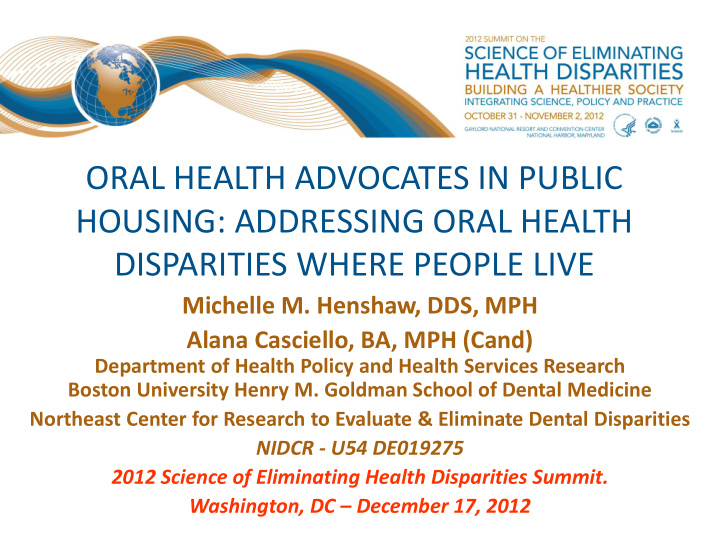



ORAL HEALTH ADVOCATES IN PUBLIC HOUSING: ADDRESSING ORAL HEALTH DISPARITIES WHERE PEOPLE LIVE Michelle M. Henshaw, DDS, MPH Alana Casciello, BA, MPH (Cand) Department of Health Policy and Health Services Research Boston University Henry M. Goldman School of Dental Medicine Northeast Center for Research to Evaluate & Eliminate Dental Disparities NIDCR - U54 DE019275 2012 Science of Eliminating Health Disparities Summit. Washington, DC – December 17, 2012
NIDCR EARLY CHILDHOOD CARIES COLLABORATING CENTERS (EC4) NIDCR Cooperative Agreements with: • University of California, San Francisco Center to Address Disparities in Children’s Oral Health (CAN DO) and Data Coordinating Center (DCC) – Stuart Gansky, PI, Steve Gregorich, DCC Director U54 DE019285 www.ucsf.edu/cando • Boston University Goldman School of Dental Medicine Northeast Center for Research to Evaluate and Eliminate Dental Disparities (CREEDD) – Raul Garcia and Michelle Henshaw, Co-PIs U54 DE019275 www.bu.edu/creedd • University of Colorado Denver Center for Native Oral Health Research (CNOHR) – Judith Albino, PI U54DE019259 http://aianp.uchsc.edu/cnohr/index.html 2
CENTER FOR RESEARCH TO EVALUATE AND ELIMINATE DENTAL DISPARITIES www.bu.edu/creedd
CREEDD ‘THEMES’ Oral health promotion and disease prevention In “non - dental care” settings – The ‘well - child’ medical care visit, in community health clinics – Public housing developments Delivered by “non - dental care” providers – Medical care providers (MD/NP/RN/PA) – Public housing residents
CREEDD COMPONENTS Center Co- PI’s Raul Garcia, DMD, and Michelle Henshaw, DDS, MPH Major Projects and Co- PI’s “Partnering with Community Health Centers to Prevent Early Childhood Caries” Judith Bernstein, PhD, and Paul Geltman, MD, MPH Boston University Schools of Medicine and Public Health Norman Tinanoff, DDS, University of Maryland Dental School “Oral Health Advocates in Public Housing” Michelle Henshaw, DDS, MPH, Boston University, and Belinda Borrelli, PhD, Brown University School of Medicine
THE OHAPH PARTNERSHIP • Boston Housing Authority • Partners in Health and Housing-Prevention Research Center (CDC U48 DP00058 ) – Resident Health Advocate (RHA) Program • Community Committee for Health Promotion (CCHP) • CREEDD
PUBLIC HOUSING • Subsidized housing to low and moderate income individuals and families managed by the state or non-profit organizations • 7.9 million individuals live in public housing • Average annual household income is $13,543 . – Federal poverty line is $15,130 for a household of 2, and $19,090 for a household of three according to the 2012 United States Health and Human Services Poverty Guideline From: Public Housing Resident Characteristics Reports as of August 31, 2012.
BOSTON PUBLIC HOUSING (BHA) Largest landlord in Boston, Massachusetts – The BHA has 63 (37 elderly/disabled; 26 family) developments in almost every neighborhood in the City of Boston. – The BHA currently owns approximately 14,000 units of housing in Boston and houses about 27,000 people under the public housing program. Tenant task forces Resource and development centers Child care centers Recreation centers Built near community health centers
ORAL HEALTH DISPARITIES What we know: Racial and ethnic minority groups and individuals living in poverty are disproportionately affected by dental disease Boston Public Housing: – Median household income is typically well below the national poverty line • The annual household income of 57.9% of Boston families living in public housing is less than $20,000. – Of families with young children, 54% are Hispanic, 33% are Black, Non- Hispanic and 6.7% are White, Non-Hispanic
ORAL HEALTH AND PUBLIC HOUSING What we have observed: Healthy Baby/Healthy Child Oral Health Study – Clients primarily public housing residents – 36% of children aged 0-3 had signs of ECC – 73% of mothers with untreated decay Boston modified Behavioral Risk Factor Surveillance System (BRFSS): – Residents have poorer health status for virtually all measures compared with non-residents, after controlling for SES – Residents more than twice as likely as non-residents to not have had a preventive dental visit
PROJECT DESIGN: COMMUNITY INPUT Open forums with the CCHP and Focus Groups – Research design • Importance of peer interventionists – Staff recruitment • Identificaton of community research personnel – Recruitment materials – Sub-committee for review of research instruments
ORAL HEALTH ADVOCATES IN PUBLIC HOUSING
ORAL HEALTH ADVOCATES IN PUBLIC HOUSING Research question: Does a behavioral intervention (Motivational Interviewing), delivered by public housing residents (‘oral health advocates’) to their peers, reduce incidence of early childhood caries over a two-year period?
ORAL HEALTH ADVOCATES IN PUBLIC HOUSING Study design: Stratified group randomized trial Primary outcome assessment: 2 year caries incidence Intervention: Everyone receives oral health education, oral health assessments, fluoride application and referral Intervention group – receives the oral health information via an oral health advocate trained in MI Control group – receives written oral health information
ORAL HEALTH ADVOCATES IN PUBLIC HOUSING Target: Enroll 1,860 caregivers and their children between the ages of 0 and 5 years from 26 public housing developments Progress to date: Enrolled 814 caregivers and a total of 1038 children between the ages of 0 and 5 years from 21 public housing developments
CHALLENGES • Project development: – Partnership development requires long term commitment and resources prior to grant support • Implementation: – Unreliable/unstable communication methods (e.g. disconnected phone numbers/limited calling plan) – Residents’ reluctance to be ‘study subjects’ – Recruitment and retention resource intensive
SUCCESSES Early Childhood Caries Collaborating Centers (EC4) • Development of Behavioral Risk Factor Questionnaire (BFRQ) • Development of caries calibration model for Early Childhood Caries (ECC) Oral Health Advocates in Public Housing (OHAPH) • Developed model for training lay persons to deliver Motivational Interviewing (MI) focusing on early childhood caries – Successfully trained interventionists and maintained high level of fidelity • Community engagement – Build effective partnerships – Identify and utilize all access points into your community • Recruitment and retention strategies effective in public housing settings
THANK YOU!
Recommend
More recommend